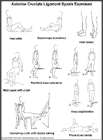
Anterior Cruciate Ligament Injury (ACL) Rehabilitation Exercises
You may begin with the first 3 exercises immediately. When swelling in your knee has gone down and you are able to stand with equal weight on both legs, you may do the remaining exercises.
- Heel slide: Sit on a firm surface with your legs straight in front of you. Slowly slide the heel of your injured leg toward your buttock by pulling your knee to your chest as you slide. Return to the starting position. Do 3 sets of 10.
- Quadriceps isometrics: Sitting on the floor with your injured leg straight and your other leg bent, press the back of your knee into the floor by tightening the muscles on the top of your thigh. Hold this position 10 seconds. Relax. Do 3 sets of 10.
- Prone knee bends: Lie on your stomach with your legs straight out behind you. Bend your knee so that your heel comes toward your buttocks. Hold 5 seconds. Relax and return your foot to the floor. Do 3 sets of 10. As this becomes easier you can add weights to your ankle.
- Passive knee extension: Do this exercise if you are unable to fully extend your knee. While lying on your back, place a rolled up towel underneath the heel of you injured leg so it is about 6 inches off the ground. Relax your leg muscles and let gravity slowly straighten your knee. You may feel some discomfort while doing this exercise. Try to hold this position for 2 minutes. Repeat 3 times. Do this exercise several times per day. This exercise can also be done while sitting in a chair with your heel on another chair or stool.
- Heel raises: Balance yourself while standing behind a chair or counter. Raise your body up onto your toes and hold it for 5 seconds, then slowly lower yourself down. Repeat 10 times. Do 3 sets of 10.
- Knee stabilization: Wrap a piece of elastic tubing
around the ankle of your uninjured leg. Tie the tubing
to a table or other fixed object.
- Stand on your injured leg facing the table and bend your knee slightly, keeping your thigh muscles tight. While maintaining this position, move your uninjured leg straight back behind you. Do 3 sets of 10.
- Turn 90° so your injured leg is closest to the table. Move your uninjured leg away from your body. Do 3 sets of 10.
- Turn 90° again so your back is to the table. Move your uninjured leg straight out in front of you. Do 3 sets of 10.
- Turn your body 90° again so your uninjured leg is closest to the table. Move your uninjured leg across your body. Do 3 sets of 10.
Hold onto a chair if you need help balancing. This exercise can be made even more challenging by standing on a pillow while you move your uninjured leg.
- Wall squat with a ball: Stand with your back, shoulders, and head against a wall and look straight ahead. Keep your shoulders relaxed and your feet 1 foot away from the wall and a shoulder's width apart. Place a rolled up pillow or a soccer-sized ball between your thighs. Keeping your head against the wall, slowly squat while squeezing the pillow or ball at the same time. Squat down until you are almost in a sitting position. Your thighs will not yet be parallel to the floor. Hold this position for 10 seconds and then slowly slide back up the wall. Make sure you keep squeezing the pillow or ball throughout this exercise. Repeat 10 times. Build up to 3 sets of 10.
- Resisted knee extension: Make a loop from a piece of
elastic tubing by tying it around the leg of a table or
other fixed object. Step into the loop so the tubing
is around the back of your injured leg. Lift your
uninjured foot off the ground. Hold onto a chair for
balance, if needed.
- Bend your knee about 45 degrees.
- Slowly straighten your leg, keeping your thigh muscle tight as you do this.
Do this 10 times. Do 3 sets. An easier way to do this is to perform this exercise while standing on both legs.
Written by Tammy White, MS, PT, and Phyllis Clapis PT, MS, OCS.
Published by McKesson Health Solutions LLC.
This content is reviewed periodically and is subject to
change as new health information becomes available. The
information is intended to inform and educate and is not a
replacement for medical evaluation, advice, diagnosis or
treatment by a healthcare professional.
Copyright © 2003 McKesson Health Solutions LLC. All rights reserved.

